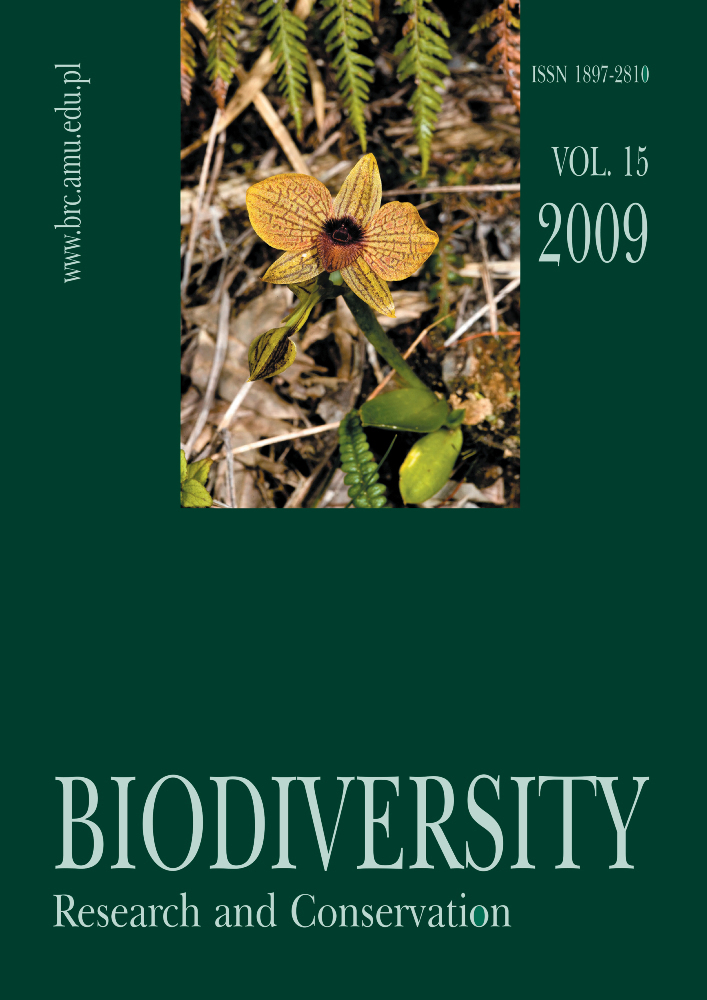Abstract
Apophytes are native synanthropic plants, i.e. those found in disturbed habitats. Some apophytes with a limited geographic range, which are native to one part of a country, migrate out of their natural communities as "invasive" plants. We selected from the group of apophytes in Poland (more than 220 species) examples of such plants, which after World War II colonized new areas and often new habitats. They include, for instance, coastal species of dunes and salt marshes, or plants used as ornamentals. Moreover, some species of fresh meadows in the south of Poland, are now found in the north in ruderal habitats. The speed of colonization is high, such that in the last 20 years, starting from a few locations, some have taken over almost the entire area of Poland. The expansion of apophytes can be much faster than that of anthropophytes because apophytes have a higher number of diaspores or a shorter period of adaptation in new localities.
References
Benkert D., Fukarek F. & Korsch H. 1996. Verbreitungsatlas der Farn- und Blütenpflanzen Ostdeutschlands. 615 pp. Gustav Fischer Verlag, Jena.
Browicz K. & Gostyńska M. 1963. Sorbus intermedia (Ehrh.) Pers. In: Białobok S. & Czubiński Z. (eds.). Atlas of Distribution of Trees and Shrubs in Poland, 2: 7-8. Zakład Dendrologii i Arboretum Kórnickie PAN, PWN, Poznań.
Haeupler H. & Schönfelder P. 1988. Atlas der Farn und Blütenpflanzen der Bundesrepublik Deutschland. 768 pp. Verlag Eugen Ulmer, Stuttgart.
Holub J. & Jirásek V. 1967. Zur Vereinheitlichung der Terminologie in der Phytogeographie. Folia Geobot. Phytotax. 1(2): 69-113.
Jackowiak B. 1984-1985. Chorologiczne i synekologiczne aspekty ekspansji Puccinellia distans (Jacq.) Parl. w Polsce. Bad. Fizjogr. Pol. Zach. seria B-Botanika 35: 67-91.
Jackowiak B. 1996. Chorological-ecological model of spread of Puccinellia distans (Poaceae) in Central Europe. Fragm. Flor. Geobot. 41(2): 551-561.
Kornaś J. 1955. Charakterystyka geobotaniczna Gorców. Monogr. Bot. 3: 1-216.
Landolt E. 1970. Mitteleuropäische Wiesenpflanzen als hybridogene Abkömmlinge von mittel-und südeuropäischen Gebirgssippen und submediterranen Sippen. Feddes Repertorium 81: 61-66.
Pawłowska S. 1965. La provenance de la flore des prairies fauchables de la partie septentrionale des Tatras et de la Région Subtatrique. Fragm. Flor. Geobot. 11(1): 33-52.
Rybniček K. & Rybničková E. 1974. The origin and development of waterlogged meadows in the central part of Šumava Foothils. Folia Geobot. Phytotax. 9: 45-70.
Sawilska A. K. & Misiewicz J. 1998. New localities for Parietaria pensylvanica (Urticaceae) in Poland. Fragm. Flor. Geobot. 43(2): 231-236.
Scholz H. 1975. Grassland evolution in Europe. Taxon 24: 81-90.
Thellung A. 1918-1919: Zur Terminologie der Adventivund Ruderalflora. Allg. Bot. Zeitschr. Karlsruhe, 24: 36-43.
Tokarska-Guzik B. 2005. The Establishment and Spread of Alien Plant Species (Kenophytes) in the Flora of Poland. Prace naukowe Uniw. Śląskiego w Katowicach 2372: 1-192.
Trzcińska-Tacik H. 1966. Flora and vegetation of the spoil mounds of the Cracow Soda Factory. Fragm. Flor. Geobot. 12(3): 243-319.
Zając A. & Zając M. (eds.). 2001. Distribution Atlas of Vascular Plants in Poland. xii+714 pp. Edited by Laboratory of Computer Chorology, Institute of Botany, Jagiellonian University, Cracow.
Zając A., Zając M. & Tokarska-Guzik B. 1998. Kenophytes in the flora of Poland: list, status and origin. In: J. B. Faliński, W. Adamowski & B. Jackowiak (eds.). Synantropization of plant cover in new Polish research. Phytocoenosis 10 (N. S.) Suppl. Cartogr. Geobot. 9: 107-116.
Zając M. & Zając A. 1992. A tentative list of segetal and ruderal apophytes in Poland. Zeszyty Naukowe UJ, Prace Bot. 24: 7-23.




